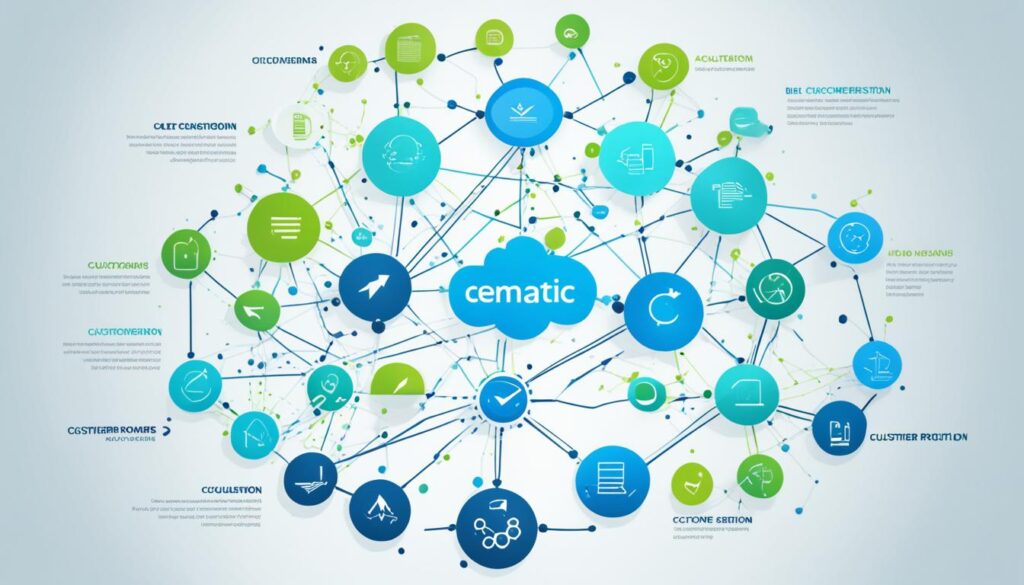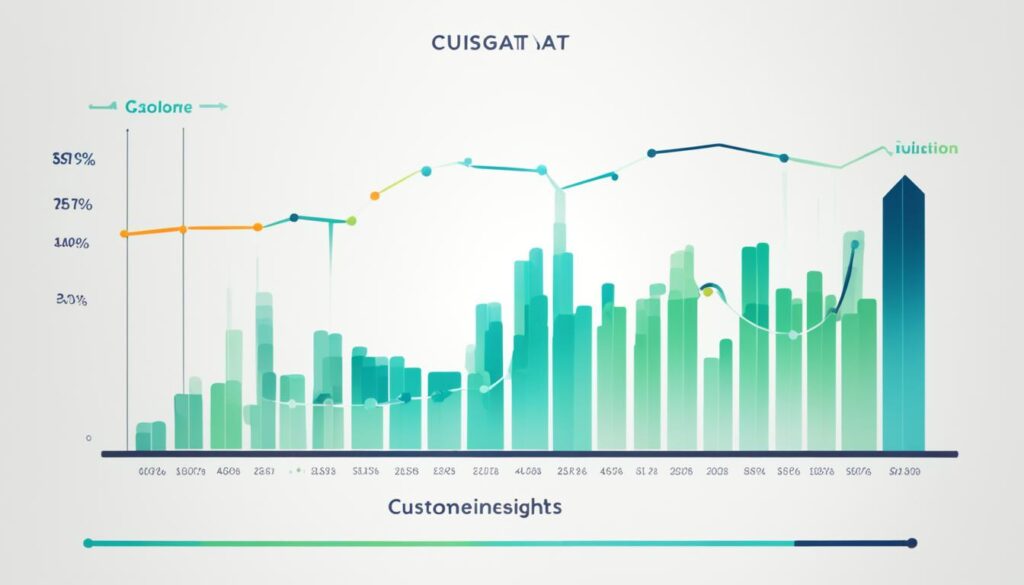Welcome to the world of data-driven customer acquisition strategies powered by Big Data. In today’s competitive market, finding new customers is a top priority for businesses. With the advancements in Big Data analytics, companies can now leverage data insights to optimize their customer acquisition efforts and attract new customers more effectively.
By incorporating data from various sources, such as device sensors, user session data, and app store data, marketers can gain a comprehensive understanding of customer profiles and lifecycle. This enables them to eliminate guesswork and make data-driven decisions for acquiring new users.
Big Data analytics complements traditional user data by providing additional insights from unstructured digital data. It allows marketers to delve deeper into user behavior and identify targeted marketing strategies to maximize engagement and conversion rates.
Key Takeaways:
- Data-driven acquisition strategies use Big Data analytics to eliminate guesswork and gain insights.
- Marketers can refine their customer acquisition strategies by incorporating data from various sources.
- Big Data analytics provides valuable insights into user behavior and enables targeted marketing strategies.
- Data-driven strategies help marketers assess performance and make informed decisions.
- By leveraging Big Data analytics, companies can customize messages and target new customers more effectively.
The Role of Big Data in Data Driven Acquisition
Big Data analytics plays a crucial role in driving data-driven customer acquisition strategies. By supplementing traditional user data with insights from unstructured digital data, marketers can gain a deeper understanding of user behavior and unlock valuable opportunities for new user acquisition. This enables businesses to develop targeted marketing strategies and optimize their efforts for maximum engagement and conversion rates.
Combining real-time device-driven analytics with Big Data analytics empowers marketers to make data-informed decisions and enhance their acquisition techniques. By analyzing a wide range of data sources, such as user session data, app store data, and device sensors, marketers can refine their targeting strategies and acquire new customers more effectively.
One of the major advantages of utilizing Big Data analytics is the ability to gain insights from unstructured digital data. This includes user-generated content, social media interactions, online reviews, and more. By extracting valuable insights from this data, marketers can identify patterns, preferences, and pain points of their target audience, enabling them to tailor their acquisition campaigns to be more relevant and impactful.
With Big Data analytics, marketers can go beyond surface-level data and dive deep into user behavior, enabling them to develop targeted marketing strategies that are more effective and efficient.
Moreover, Big Data analytics enables businesses to leverage real-time data and adjust their strategies accordingly. By continuously monitoring user behavior and engagement metrics, marketers can adapt their campaigns in real-time to maximize results and capitalize on emerging opportunities.
In summary, the role of Big Data in data-driven acquisition is instrumental. It empowers marketers to gain a comprehensive understanding of user behavior, identify new customer acquisition opportunities, and develop targeted marketing strategies that yield higher engagement and conversion rates.

| Benefits of Big Data in Data Driven Acquisition |
|---|
| Enhanced understanding of user behavior |
| Identification of new customer acquisition opportunities |
| Development of targeted marketing strategies |
| Optimization of efforts for maximum engagement and conversion rates |
| Real-time adjustments based on user behavior and metrics |
What is Data Driven Acquisition?
Data-driven acquisition is a strategic approach that leverages advanced algorithms and data analytics to identify the touchpoints that have the most significant impact on users. By analyzing data, marketers can gain valuable insights into user behavior, preferences, and conversion patterns to optimize their acquisition strategies effectively.
Data-driven strategies allow marketers to identify and address friction points in the customer journey, leading to improved customer engagement and higher conversion rates. Through continuous analysis and evaluation of their tactics, marketers can make informed decisions and refine their user acquisition campaigns to achieve better results.
One essential component of data-driven acquisition is customer segmentation with Big Data. By incorporating mobile CRM data, which includes valuable information such as business transactions, contacts, user feedback, and sessions, marketers can further enhance their acquisition campaigns. This segmentation enables marketers to tailor their strategies to specific customer segments, ensuring that their efforts are more targeted and personalized.

| Benefits of Data Driven Acquisition | Examples |
|---|---|
| Maximizing Engagement | Implementing personalized recommendations based on user behavior. |
| Improving Conversion Rates | Optimizing landing pages and user flows based on data insights. |
| Enhancing User Experience | Creating customized onboarding experiences for different user segments. |
| Driving Growth | Identifying untapped markets and expanding user base through targeted marketing. |
Using Big Data for new Customer Acquisition
In today’s digital landscape, acquiring new customers is essential for businesses to thrive and grow. Big Data analytics plays a crucial role in this process by providing valuable insights that help marketers optimize their strategies and attract new users. By leveraging the power of Big Data, businesses can gain a deeper understanding of their customers, identify areas for improvement, and ultimately drive better app performance.
One of the key advantages of Big Data analytics is its ability to gather insights from various sources, including existing customer data and cross-channel user data. By analyzing this data, marketers can uncover valuable information about user preferences, platform preferences, and potential pain points. With these insights in hand, they can refine their marketing techniques to generate new users more effectively.
Identifying User Preferences and Platform Preferences
Understanding user preferences is crucial when it comes to acquiring new customers. By analyzing Big Data, marketers can gain valuable insights into what users are looking for and tailor their marketing campaigns accordingly. For example, through data analysis, they can identify which features or benefits are most appealing to users and emphasize them in their messaging.
Additionally, Big Data analytics can reveal important platform preferences. By analyzing user behavior across different platforms, marketers can determine which channels are most effective for reaching their target audience. This information allows them to allocate their resources more efficiently and focus on channels that yield the highest return on investment.
Optimizing Marketing Techniques for New User Acquisition
Big Data analytics also helps marketers optimize their marketing techniques to attract new users. Through data analysis, they can identify areas for improvement and make data-driven decisions to enhance their strategies. For example, they can determine the most effective channels, messages, and creative formats to engage potential customers.
“Big Data analytics enables marketers to make informed decisions and develop highly targeted campaigns that resonate with their audience, leading to improved app performance and user acquisition.”
By leveraging Big Data insights, marketers can answer key questions such as:
- What are users’ interests and preferences?
- Which platforms do users prefer?
- What pain points do users experience?
- How can marketing techniques be optimized to attract new users?
Answering these questions allows businesses to refine their customer acquisition strategies, improve targeting and efficiency, and ultimately drive better results.

As shown in the image above, Big Data analytics helps businesses acquire new customers by providing valuable insights from diverse sources. By leveraging these insights, companies can optimize their marketing techniques, attract new users, and drive business growth.
More Target Oriented Promotions by Combining Diverse Sources of Data
With the availability of diverse sources of data, businesses can unlock valuable insights to optimize their targeted marketing strategies and drive successful customer acquisition campaigns. By combining data from various sources and drawing actionable insights, businesses can create personalized and effective promotions that resonate with their target audience. In today’s data-driven era, leveraging Big Data analytics is essential for obtaining the necessary customer insights that go beyond traditional organizational databases.
One of the key advantages of utilizing Big Data analytics is the ability to customize messages based on specific customer segments. Analyzing transaction history allows businesses to understand customer preferences and make tailored offers. By incorporating profile demographics, businesses can target specific demographic groups and refine their messaging accordingly. Understanding user behavior patterns, such as browsing habits and purchase history, enables businesses to deliver personalized recommendations and promotions, increasing the chances of attracting new customers.
Social media interactions provide a treasure trove of data that can be leveraged for targeted marketing strategies. By analyzing social media activity, businesses gain insights into customer interests, preferences, and influencers they follow. This information can be used to devise campaigns that align with customer interests and effectively target potential new customers.
To further illustrate the power of combining diverse sources of data, consider the following example:
| Data Source | Insights |
|---|---|
| Transaction History | Customer preferences, purchase patterns |
| Profile Demographics | Age, gender, location |
| User Behavior Patterns | Product preferences, browsing habits, engagement level |
| Social Media Interactions | Interests, influencers followed, brand sentiment |
By combining these different data sources, businesses can develop targeted marketing strategies that capture the attention of potential customers and drive increased conversion rates. These strategies may include personalized email campaigns, targeted social media ads, or tailored website content. The ability to derive customer insights from disparate data sources allows businesses to make informed decisions and deploy data-driven tactics that set them apart from competitors.
By recognizing the potential of Big Data and implementing targeted marketing strategies, businesses can unlock new customer acquisition opportunities and enhance their bottom line. The data-driven approach empowers businesses to deliver relevant and personalized promotions that attract and engage prospective customers. Leveraging customer insights obtained from diverse data sources adds a competitive edge to any user acquisition campaign.
Conclusion
Data-Driven Customer Acquisition Strategies, powered by Big Data analytics, are pivotal in attracting new customers and driving business growth. Leveraging data insights allows companies to fine-tune their customer acquisition techniques, enhance targeting and efficiency, and make well-informed decisions.
Big Data analytics enables companies to adopt personalized and targeted marketing approaches, resulting in improved engagement, customer retention, and overall business performance. By harnessing the power of data, businesses can identify the right audience, deliver tailored messaging, and optimize campaigns for maximum impact.
However, it’s essential to remember that a sustainable growth strategy goes beyond acquiring new customers. Engaging and retaining customers through data-driven strategies are equally crucial. By continuously monitoring and analyzing customer data, companies can adapt, refine, and optimize their approaches, ensuring long-term success.
FAQ
What is data-driven customer acquisition?
Data-driven customer acquisition is a strategy that utilizes big data analytics to gain insights into customer profiles and behaviors, allowing businesses to effectively attract and acquire new customers.
How does big data play a role in data-driven acquisition?
Big data analysis provides comprehensive insights from various sources, such as device sensors and user session data, allowing marketers to identify new user acquisition opportunities and refine their customer acquisition strategies.
What is customer segmentation with big data?
Customer segmentation with big data involves analyzing diverse sources of data to understand user preferences, platform preferences, potential pain points, and areas for improvement. This enables businesses to customize messages and target new customers more effectively.
How can big data be used for new customer acquisition?
By analyzing data from transaction history, user behavior patterns, and social media interactions, businesses can gather insights to inform their new customer acquisition strategies. This allows for personalized and effective marketing approaches.
How can combining diverse sources of data enhance targeted marketing?
Combining data from various sources, such as transaction history, profile demographics, and social media interactions, allows businesses to orchestrate personalized and effective new user acquisition campaigns. This helps in customizing messages and targeting new customers more effectively.
How do data-driven customer acquisition strategies using big data benefit businesses?
Data-driven customer acquisition strategies powered by big data analytics help businesses refine their acquisition techniques, improve targeting and efficiency, and make more informed decisions. It enables personalized and targeted marketing approaches, leading to improved engagement, retention, and overall business performance.







